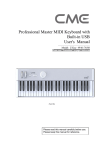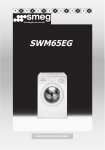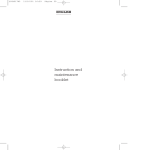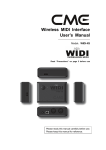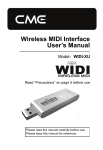Download Elba EWF-B6151WH Operating instructions
Transcript
Contents Warnings 2 Description of the machine 3 Installation 3 Operating instructions 6 Maintenance 8 Program tables 11-13 Control panel 13-15 Technical characteristics 15 1 Welcome! Thank you for choosing our washing machine. Please read the following instructions carefully for easy and safe usage of the machine’s many functions. WARNINGS T he equipment must only be used as a domestic washing machine. Any other use will be considered improper and therefore dangerous. Do not touch the machine with wet hands or feet. Do not allow children to operate the machine. The machine must only be opened on completion of the washing cycle. Should the need arises, switch off the machine by pressing knob (p) or by pressing and releasing the stop pushbutton if fitted. If the machine is located on a carpet floor, ensure that there is a circulation of air between the machine feet and the carpet. Carpet must not obstruct the openings in the base. If the supply cord is damaged, it must be replaced by manufacturer or its service agent or a similarly qualified person in order to avoid a hazard. This appliance is not intended for use by persons (including children) with reduced physical, sensory or mental capabilities, or lack of experience and knowledge, unless they have been given supervision or instruction concerning use of the appliance by a person responsible for their safety. Children should be supervised to ensure that they do not play with the appliance. 2 □ Do not remove or insert the socket with wet hands. □ The machine must be connected to a power supply with an efficient earth connection, according to the law □ Do not use an extension lead. □ Do not expose the machine to atmospheric agents. □ The machine cannot be opened until three minutes after the cycle has finished or the machine has been switch off. □ For maintenance work , disconnect the machine from the power supply. □ Do not pull the power feed cable or the equipment to remove the plug from the power socket. □ After use, it is advisable to disconnect the machine from the power supply and close the water supply tap. DESCRIPTION OF THE MACHINE T he washing machine is a domestic appliance that is used to wash various types of fabrics. The machine is constructed from panels treated and painted such that high aesthetic quality is achieved. The motor and all moving parts have been designed and manufactured to provide quiet operation. The stainless steel drum is large and well mounted for a better quality wash and longer linen life. The control panel ensures easy selection of all the wash cycles desired. The large door makes loading and unloading the washing easier*. Its excellent stability is the result of extensive research into the equilibrium of masses in movement. INSTALLATION Warning! Installation must be carried out by qualified personnel and according to the manufacturer’s instructions. Incorrect installation may cause damage or injury to persons. The machine can be installed on any flat surface, with the ambient temperature not less than 3℃ and that the cables and pipes at the rear of the machine are not crushed. Unpacking T ransport the machine near to its installation place and remove the external packing (Fig.2). If the integrity of the machine is in doubt, do not use it. Seek advice from qualified personnel. Fig 2 * See control panel (page 14) and program tables (page 11-13) 3 Warning! For transport reasons, the suspended unit located in the machine is locked in position by four distance pieces and screws. Before operating the machine, remove the blocking screws and insert four plastic caps to each hole accordingly. (Fig.3) Save the screws and distance pieces for future use. Once the screws and packing spacers have been removed, it is necessary to insert the plugs provided, which can be found inside the bag containing the documents. Installation Electrical Connection Water connection Fig 3 Carefully transport the machine to the connection points. The appliance must be positioned so that the plug is accessible. For proper operation, the machine should be installed on a flat, level surface. Levelling can be carried by adjusting the feet (Fig.4) on the machine. Once the machine is level, block the feet by tightening the lock nuts with a spanner. Check that the voltage written on the technical data table inside the manual corresponds to the mains supply voltage. The counter, pressure relief valve, supply lines and power connection have all been designed for the maximum load requested. Insert the plug in the socket, ensuring that it is fitted with an earth (Fig.5) If the electrical socket in which the plug of the machine is inserted is unsuitable, have the socket replaced by qualified personnel. It is good practice to avoid the use of adapters, extension leads and multiple sockets*. T urn on the tap and allow a good quantity of water to flow until it is clear and free from impurities. This procedure is especially applicable in the case of new water systems or those that have remained unused for some time. Connect the water supply hose to the tap; inserting the filter provided, and hand tighten (Fig.6). Check that the other end of the hose is tight on the inlet (Fig.7). Position the discharge hose at a minimum height of 60cm, though not more than 90cm, from the ground (Fig.8). N.B. To prevent siphoning, do not hermetically seal the machine’s discharge hose. Remember that the hoses must not be squashed when manoeuvring the machine against the wall. The appliance is to be connected to the water mains using new hose-sets and that old hose-sets should not be reused. Fig 4 Fig 5 Fig 7 Fig 8 * See warnings (page 2) 4 Fig 6 Stain removal Not all stains can be removed by machine washing. The following instructions describe the treatment to be given to material prior to being loaded in the machine, in order to avoid an unsuccessful wash and the formation of residual discolouring. Wax: Remove the wax with a non-cutting edge in order to remove as much as possible, then place a sheet of paper between an iron and the stained item. Ball point and felt tip pens: Reduce the stain with the aid of a soft cloth soaked in colourless 90°alcohol. Be careful not to spread the stain. Damp marks and mildew: After having checked that the item is colorfast on a non-visible part, put it to soak in water with added bleach. Otherwise, place the item in 10% oxygenated water and leave for 10-15 minutes. Ironing marks: If the fabric is slightly marked, use the procedure described for mildew. Rust: Use an anti-rust product following the manufacturer’s instructions. Chewing gum: Dilute using acetone and remove with a clean cloth. Paint: Do not wait for the paint to dry. Treat immediately with the solvent indicated on the paint container (water, turps, trichloroethylene). Wash with soap and water, then rinse. Lipstick: Dab with ether if the item is wool or cotton, or with trichloroethylene if it is silk. Nail varnish: Place the stained part of the item on a sheet of absorbent paper, and then wet the other side of the item with acetone. Ensure that the sheet of absorbent paper is changed frequently. Continue until the stain has completely disappeared. Metal stains: Apply lemon juice until the stain has completely or almost disappeared. Grease or tar: Spread some fresh butter on the stain, leave for a while then dab with oil of turpentine. Grass: Soap delicately, treat with dilute bleach. For woollens, 90° alcohol can give good results. Description of washing symbols Before putting the material in the machine, examine the clothing label in order to select the correct washing programme. The table illustrated below may be helpful. 5 OPERATING INSTRUCTIONS For each wash ensure that: The water supply connections are secured*, the tap is turned on (Fig.10) and the discharge hose is positioned correctly. The programme selector (P) is in the stop position (STOP). Then, with dry hands, insert the plug in the power socket (Fig.11). Sort the washing into fabric types**. Check that there are no objects in the pockets of the clothing to be washed which may damage the fabric, washing machine or filter. Open the door (Fig.12). Load the washing in the machine and close the door. N.B.Using detergent (Fig.13) (Fig.14) Each product poured into its respective section must not be allowed to overflow. Should the detergent enter the softener section, the washing will be rinsed in soapy water, leaving white marks. Vice versa, if the softener enters the detergent section during the washing cycle, efficiency will be affected. Add the reduced lather detergent and softener (if required) specially made for automatic washing machined). For the dosage, refer to the instructions on the packet. In the case of soft water, reduce the dosage. N.B. Excessive use of softener may damage the fabric. Close the soap powder container (Fig. 15). Warning! Do not remove the soap powder container while the machine is in operation, as this may cause water to spill out. Select the most suitable programme and correct temperature from the programme table***. Fig 10 Fig 13 Fig 11 Fig 14 Fig 12 Fig 15 * See “Water connection” (page 4) ** See “Clothing symbols” (page5) *** See Program tables (page 1111-13) 6 Pre-set using the “Adjustable thermostat (T) and programmer” (P) knob. Warning! Do not rotate the programmer knob (P) in an anticlockwise direction. Fig.16 Fig.17 Fig.18 Fig.19 Press the no-spin pushbutton if required (Fig.16). When this pushbutton is pressed, the machine completes the wash cycle without spinning. This option is useful for the wash-n-wear clothing. If the washing weighs 1/2kg or less, press the half-load pushbutton (Fig.17). Light soiled materials option. Press the water saving pushbutton if required (Fig.18) and the machine will complete automatically with one less rinse in the process to save water. Max. temperature option. Press the energy saving pushbutton if required (Fig.19 ) and the Max. temperature will be limited to 60℃ to save energy. To start the machine, pull the program knob (P) if required (Fig.21), or if the machine has pushbutton, press the start pushbutton (Fig.20): the luminous indicator will light up. If the required program position is accidentally passed, interrupt the program by pressing the programmer knob (P) (Fig.21), or , if fitted, press the start pushbutton to turn the machine off (Fig.20). Rotate the programmer (P) in a clockwise direction until the required position is reached. Pull the programmer knob out again (P) (Fig.21) or, if fitted, press the start pushbutton (Fig.20). It is always possible, though not advisable, to add clothes which have been leftover during the main washing cycle. To do this, proceed as follows: Always check, by looking through the transparent door, that there is no water in the drum, otherwise rotate programmer knob (P) to the discharge position. If there is no water in the drum, press programmer knob (P) (Fig.21), or press and release the stop pushbutton if fitted (fig.20). Wait approximately 3minutes (Fig.22) to allow the safety devices to de-activate. Open the door (Fig.12); add the leftover clothing and re-close the door. If required, add low lather detergent. To start the machine, pull programmer knob (P) (Fig.21), or if the machine has pushbuttons, press the start pushbutton (Fig.20). The indicator light will be illuminated (Fig.23). At the end of the washing program, the machine will stop at one of the STOP positions on the programmer (P). Press the programmer knob (P) (Fig.21), or press and release the stop pushbutton if fitted (Fig.20). Wait three (3) minutes for the door to unlock (Fig.22). Remove the washing. With dry hands, disconnect the machine from the mains supply (Fig.11). Turn off the water tap (Fig.24). Fig.20 Fig.21 Fig.22 Fig.23 Fig.24 7 MAINTENANCE Introduction Our washing machine does not need any particular or complicated maintenance operations, in that it has been designed for a long working life. Nevertheless, some care and attention are recommended*. Before carrying out the following operations, ensure that the machine is disconnected from the electricity supply (Fig.11) and the water is turned off (Fig.25). Periodic soap Powder Container cleaning T his is carried out each time when there is a build up of soap powder in the container. T he procedure can be carried out simply by extracting the pull-out container from its housing (a sharp pull is required to overcome the stopper) (Fig.26) and rinsing it under a jet of water. The machine must not be cleaned with solvents. A slightly soapy wet cloth is sufficient. Pump filter cleaning T his is carried out periodically. Ensure the machine is empty and there is no water in the tub and the electricity supply is disconnected (Fig.5). The operation is carried out by placing a basin or cloth under the filter Fig.25 cover to soak residual water (Fig.27). The filter is removed from its seating by rotating it half a turn in an anticlockwise direction and pulling outwards (Fig.28). The filter is cleaned under a jet of water, ensuring that all trapped particles are removed. Then replace the filter in its housing, rotating it clockwise until it locks in position (Fig.29). Fig.26 Fig.27 Fig.28 *See “Warning” (page 2) 8 Fig.29 IF THE MACHINE DOES NOT WORK Before consulting the technical assistance service, check that the following operations have been carried out. This may lead to a saving in both time and money. Does not work (indicator light off) Check that: 1) The power supply is available at the mains. 2) The plug is inserted correctly in the socket. 3) The programmer knob (P) is pulled out, or the start pushbutton (if fitted) is pressed*. 4) The door is closed. 5) Consult technical assistance. Does not work (indicator light on) Check that: 1) The programmer knob (P) is on the selected program. 2) Refer to problem “Does not take in water”. Does not Take in water Takes in and discharges water Continuously Does not discharge water and does not spin Check that: 1) Water is present in the supply system. 2) The tap is turned on. 3) The water feed hose is not kinked. 4) With the power disconnected, clean the inlet filter located between the tap and discharge hose**. 5) Consult technical assistance. Check that: 1) The discharge hose is at the correct height (60-90cm) ***. 2) The discharge hose outlet is not submerged under water. 3) Consult technical assistance. Check that: 1) The discharge hose is positioned correctly. 2) The discharge hose is not kinked. 3) The detergent hose is not excessive. 4) The soap powder container is not blocked. 5) The detergent is the correct type for the washing machine. * See “Use of the machine” (page 6) ** See fig .7 (page 4) *** See fig.8 (page 4) 9 Vibrates or is noisy The door does not open Check that: 1) Large articles (sheets, tablecloths, etc.) are not tangled or folded. 2) The washing machine is standing correctly on its feet *. 3) The four packing screws and distance pieces have been removed**. 1) Wait 3 minutes after the program has finished. Try to start the machine to see whether the problem has been solved. If the problem persists, call for technical assistance. * See Fig.4 (page 4) ** See Fig.3 (page 4) 10 MAIN PROGRAMS FOR RESISTENT FABRICS Knob Knob (P)* (T)** 1 2 3 4 90℃ 90℃ 90℃ 60℃ Fabric Cotton, linen, hemp Examples and degree of soiling Sheets, white and solid colour tablecloths, heavy soil, underwear Cotton, linen, Coloured underwear, shirts resistant, bath robes, cotton knits, mixes sheets, normal soil Cotton, linen, hemp Sheets, white and solid colour tablecloths, light -soil, underwear Cotton, linen, Coloured underwear, shirts resistant, bath robes, cotton knits, mixes sheets, normal soil Dispenser compartments Program description Use of supplementary buttons 1,2,3 Prewash,mainwash,3 As As As As rinses, softener, empty required required required required and final spin 2,3 Prewash,mainwash,3 As As As As rinses, softener, empty required required required required and final spin 2,3 Main wash, 3 rinses, As As softener, empty and required required final spin _ As required 2,3 Main wash, 3 rinses, As As softener, empty and required required final spin _ As required AUXILIARY PROGRAMS FOR RESISTENT FABRICS Knob Knob (P)* (T)** 5 6 7 Any position Fabric Program Cotton, linen, hemp and resistant, mixes Fast rinse Any Cotton, linen, Whitener, scented softener position hemp and resistant mixes Any Cotton, linen, position hemp and resistant, mixes Dispenser compartments Program description 3 3 Fast spin ___ Use of supplementary buttons 3 rinses, softener, As As empty and final spin required required __ As required 1 rinses, softener, empty and final spin __ As required __ As required Empty and final spin __ __ __ As required 11 GENTLE ACTION PROGRAMS FOR SYNTHETICS AND MIXES Knob Knob (P)* (T)** Fabric Example and degree Dispenser of soiling compartments 8 60℃ Resistent mixes Shirts, sheets, baby wear nappies; heavy soil 1,2,3 9 40℃ Resistent mixes Shirts, sheets, baby wear, nappies; normal soil 2,3 Use of supplementary buttons Program description Prewash , main wash, 2 rinses, softener, empty and slow spin __ Recom mended __ As required Main wash, 2 rinses, softener, empty and slow spin __ Recom mended __ As required * Position of programmer knob ** Position of adjustable thermostat knob SPECIAL WOOLLEN AND SILK PROGRAMS Knob Knob (P)* (T)** 10 11 35℃ Min. Fabric Woollen underwear Example and degree Dispenser of soiling compartments Machine washable wool Synthetics Colourfast shirts (nylon, blouses, skirts; perlon) cotton normal soil mixes Use of supplementary buttons Program description 2,3 Main wash, 2 rinses, softener empty and slow spin __ Recom mended __ 2,3 Main wash, 2 rinses, softener empty and slow spin __ Recomm ended __ * Position of programmer knob ** Position of adjustable thermostat knob 12 As required As required AUXILIARY PROGRAMS FOR WOOLLENS AND SILK Knob Knob (P)* Program (T)** Any Program description compartments Mixes, delicate 12 2 rinses, softener, Gentle rinse position Use of supplementary buttons Dispenser Fabric 3 synthetics empty and final spin __ Recom mende d __ As required Whitener, Any Mixes, delicate scented 1 rinses, softener, 13 3 position synthetics __ empty and slow spin softener Gentle As required Recom mende d __ spin Any Mixes, delicate 14 As Gentle spin position __ synthetics Empty and slow spin __ __ __ required * Position of programmer knob ** Position of adjustable thermostat knob 13 Control panel Control panel A – Program Table B – On/Off pushbutton C – No-spin pushbutton D – Half-load pushbutton E – Energy Saving pushbutton F – Water Saving pushbutton Technical characteristics 14 Rated Voltage Rated Frequency 220 ~240 V 50 Hz Water pressure range 0.05— — 1 MPa Input washing power Input spin power 315 W 750 W Heating power Maximum power 1700 W 2015 W Maximum current 9A Dimensions (cm) Height× × Width× × Depth 85× × 59.5× × 53 T – Adjustable thermostat knob P – Program knob S – On/Off indicator light















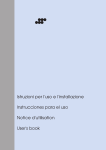
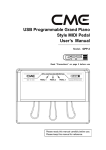
![[color=orange]THIS IS A GUIDE ON REPLACING CAPACITORS IN](http://vs1.manualzilla.com/store/data/007379770_1-0cd8feb544c0f47df80b77b27322076c-150x150.png)
